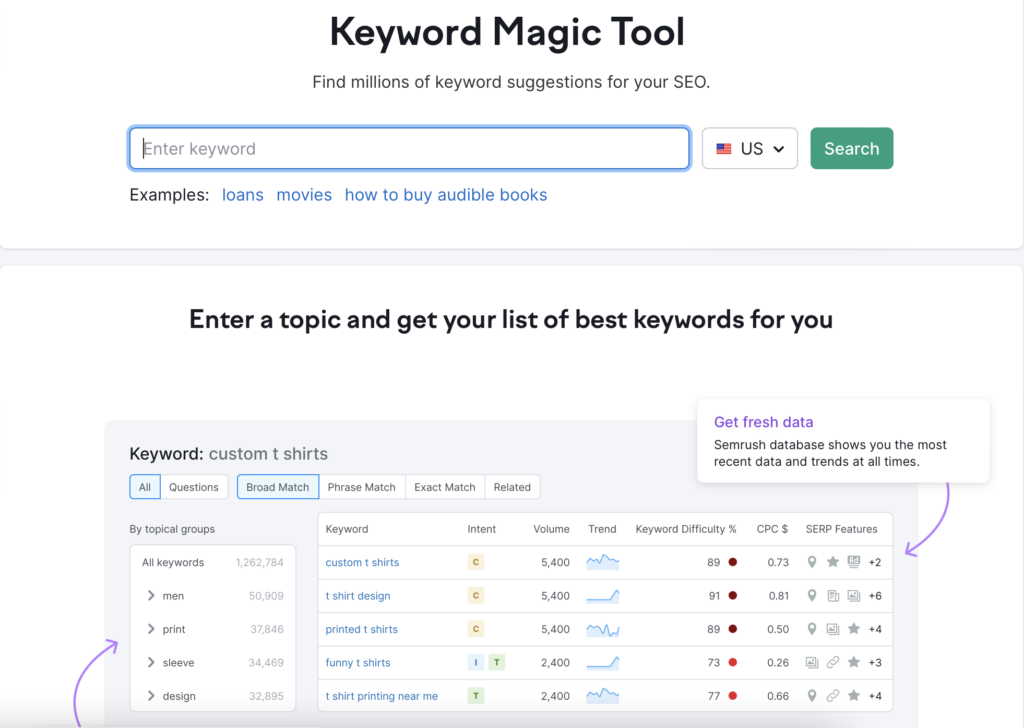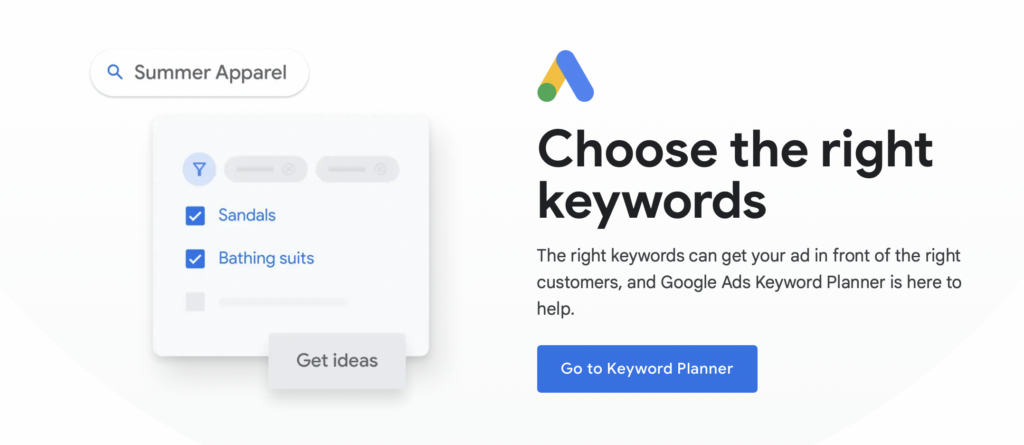AFFILIATE MARKETING
What It Is & How to Leverage it in 4 Easy Steps in 2024

When you create great content, you already know that it requires keyword research to get your customers to find you or make a purchase. If you know what they’re looking for when they search for pages like yours, you can cater to their needs. In other words, you need to know what their keyword intent is so that you can more accurately market.
What is keyword intent, and how can you leverage it for your SEO?
Let’s dive in!
What is Keyword Intent?

Before we can dive into leveraging this important concept for your SEO, it’s important to understand just what it is. Keyword intent (sometimes also referred to as search intent) is the understanding of what any given user wants to accomplish with their search query.
To identify keyword intent, you need to have a detailed understanding of your audience. Google aims to give its users exactly what they’re looking for, and it has grown in leaps and bounds when it comes to understanding search intent.
The result is a more seamless experience for the end user, but it can help you craft a well-designed website as well.
If you know what people want when they enter certain keywords, you can target all content marketing for that purpose. More people will have a positive experience on your website, get what they came for, and ultimately have the option to make a purchase when they’re ready.
How Keyword Intent Relates to Search Engine Optimization


Does knowing your keyword intent help you rank higher on Google and other search engines? The good news is that Google is very sophisticated and can pinpoint intent keywords quickly. If your website can deliver on the promise that you put out there, you may stand a chance of ranking higher in SERPs for a specific query.
For example, consider the customer who wants to “buy sneakers.” Google knows they want to make a purchase, so it shows them e-commerce websites. Someone who searches for “best sneakers for long-distance running” likely wants to learn more about various styles. Google instead shows informational articles and comparisons.
If you can nail the search intent with your content marketing, you have every chance of claiming that coveted top spot on the results pages.
Make sure to do your keyword research so that you know what your audience is searching for and can nail it on the first try.
How to Determine Search Intent


Determining search intent is as simple as paying attention to the words people put into the search box. Are they looking to buy, or are they looking for a review of a particular product or service? Is someone searching for general terms like “paintbrushes,” or do they want to know the “best paintbrushes for watercolor painters”?
This is your first and best indicator of the type of content people are looking for. As you do keyword research, pay attention to high-intent keywords (those that are likely to lead to a sale).
You can find search intent by using a tool like Keyword Magic (more on this in a minute) or simply by analyzing the top results on Google. Where are people spending their Google ads dollars? With an average cost per click of $2.69, nobody is throwing their money away on bad keywords.
This can be a good indicator that these particular keywords are likely to convert to sales, or people wouldn’t be spending money on them.
Types of Keyword Intent
Ready for more clarity on what people might be searching for when they enter a specific keyword? These five types of keyword intent will guide you to creating content that works for your unique and captive audience. There are five core reasons someone searches, so understand what they are here.
If you can master pinpointing search intent, you’re that much closer to a top spot on Google.
Commercial Intent


Maybe your ideal customer isn’t ready to buy from you — yet! They need a little more information on your products and services or a comparison of top brands in the industry. Oftentimes, you will see a customer search for reviews when they are in this commercial intent stage.
What does it mean for your business if you attract people with commercial intent? It means that they’re on the cusp of making a purchase, but they need to do a little more research. Help them along, and you might be able to score the sale.
Transactional Intent


If you were able to capture commercial intent and you did your job well, then you might be able to keep them when they transition to transactional intent. This is the stage where they are clearly ready to buy. The keyword intent moves from “reviews” or “best of” searches and starts to look a lot more like “buy.”
Informational Intent


Sometimes, people aren’t looking for a solution to their problems at all. They simply want more details on a topic that interests them. It’s all about the education process with informational intent. Could you hook them with a sale later on? Maybe, but you should focus on providing a high-quality experience in the here and now.
Give them detailed information about their desired topic, and you could score a reliable fan for life. Use this to teach someone how to do something or to answer their burning questions.


Maybe the user intent for a keyword is a little more straightforward: They want to get to a specific page somewhere on the internet. For example, let’s say that they want to pay their credit card bill, but locating the payment portal on the website is too hard. Instead, they might type in the name of their credit card company and “payment portal” to get Google to direct them there.
These are typically “low intent” keywords which means you’re unlikely to make a sale from them.
Local Intent


If you run a small brick-and-mortar local business, then you might want to leverage local intent. This is when people are specifically searching for a business in a geographic area close to them. It might be as simple as “Italian restaurants near me” or as detailed as “Carta bus stops in XYZ city.”
Understanding search intent is important here if you want to surface in the search results. These can be high-intent keywords because people are searching for businesses like yours locally. Convince them to come visit you by providing them with an excellent online experience.
How to Identify Search Intent
Whether you want informational keywords or commercial keywords, you might find that you need some support to identify search intent. Fortunately, you don’t have to figure it out all on your own. There are lots of methods you can use to start surfacing in the right search results, starting with Google.
Use Google to Your Advantage


If you’ve already done your keyword research, you know what keywords you want to rank for. Now, you need to know what the search engine is likely to show users. Google is one of the most powerful tools — and it’s free for you to start using it to your advantage. Take your keywords and plug them in to see what results come up.
Skim the data it provides you: snippets, featured images, People Also Ask, and even shopping results may all pop up. These search results lay the foundation for the type of content you should create to satisfy a searcher’s need. Even if they aren’t high-intent keywords, knowing what people expect from you can still be beneficial.
Based on what your competition is showing, you can decide how to target your content.
SEMRush & Keyword Magic Tool


If you don’t want to do the heavy lifting of searching search results, you may want to invest in a freemium tool like SEMRush. To get started and understand what informational keywords you may want to use, you can type them into the Keyword Overview tool.
Not only does it give you search intent, but it also allows you to check the competition with its SERP features. This gives you an idea of what other websites are doing to rank high on the search engines, giving you a clear path forward.
However, this isn’t the only tool that you can use to find keyword intent. SEMRush’s Keyword Magic Tool is a powerful option for finding keywords closely related to the seed keyword you were considering targeting. Type in your seed and watch as it spits out other targets along with their search intent.
Learn more in our Keyword Magic Tool review here!
How to Harness Search Intent for SEO
Once you know your intent keywords, it’s time to start leveraging them so that you show up on Google’s search engine results pages.
Here are a few ways to transform search intent into more sales and lead conversions for your brand.
Get to Know Your Audience and Niche


The first thing you should do when thinking of SEO is target a specific customer. Your audience is full of unique individuals, but they likely have some of the same pain points. If you want to show up in search results, you need to speak to those pain points and offer a solution.
Gain a deeper understanding of your audience and your niche so that you know what people are looking for when they stumble across sites like yours. To this end, you might create an ideal customer avatar or send out a survey to your best customers to find out the sort of things they are searching for on Google to brainstorm new topic ideas.
Perform Keyword Research to Find the Right Phrase


There are endless possibilities when it comes to what people will search for, no matter what their search intent might be. Don’t take a shot in the dark. Do your homework with keyword research. No substitutes for doing the heavy lifting will work. You need to have a clear idea of keyword search intent so that your content hits the mark.
You can use free tools like the Google Keyword Planner or SEMRush’s Keyword Magic Tool to clarify what people want to see from you.
Be sure to see our complete guide to keyword research and the best keyword research tools here.
Check the SERPs for Competition and Intent


Once you have narrowed down your keyword research, it’s time to see what the competition might be doing right here, right now. Your research on Google will certainly help at this stage of the game. Look at the content other sites are producing and ranking for.
Are they creating sponsored posts with Google ads or have featured snippets? Take a survey of the content, and it will give you a great idea of the commercial intent of a particular keyword.
If it doesn’t have high intent, then it may not be a keyword you want to target right now.
Knowing what the industry is doing around you will help you in the next step: creating the right content type.
Create the Right Content Type


Last but not least, your keyword intent dictates the type of content marketing you will do. You will need to center your content strategy around the search intent for your particular phrase. Whether you decide to make a video or a blog post, knowing what shows up best in the search results is key.
Target your relevant keywords and match the user search intent with your content.
Maybe it’s a sales page geared toward someone ready to buy, complete with FAQ pages to answer common objections. Maybe it’s a guide or a review for informational intent. You might even create a long-form blog post that details everything there is to know about your niche and product or service.
Final Thoughts: Getting to Keyword Search Intent
Is search intent important for helping you decide what to post and where to post it? This is one aspect of your SEO that you don’t want to leave to chance. Knowing a user’s intent makes it that much more likely that you will convert those users to paid customers when the time is right.
Whether you decide to use a tool like SEMRush or simply use Google, this guide will help you start to tease out high-intent keywords so that you can gain more readership and customers.
AFFILIATE MARKETING
Carnival Cruise Line Installs Starlink Internet on Every Ship

It’s another massive milestone for SpaceX CEO Elon Musk.
On Tuesday, Carnival Cruises announced that 100% of its ships have officially installed high-speed internet from Musk’s Starlink.
The installation took place on 90-plus ships in Carnival’s global fleet and allows for more reliable Wi-Fi when onboard (especially during remote parts of the route) for passengers and helps the ship’s staff with improving “operational and communications capabilities,” per a release from Carnival.
Related: New Jersey Man Accused of Trafficking 675 Starlink Terminals
“Starlink has been a game-changer for the onboard connectivity experience our cruise lines deliver to their guests, and we’ve already seen a surge in guest satisfaction and positive feedback from the super-fast and reliable Wi-Fi service we provide onboard,” said Josh Weinstein, CEO of Carnival Corporation in a release. “We see this technology as a win-win-win – it provides our guests with more flexibility to stay as connected as they’d like on vacation, it allows our crew to stay in touch with friends and loved ones, and it enhances our onboard operational systems.”
The installment of Starlink on Carnival ships began in December 2022 and has now expanded to all of Carnival’s smaller companies, including Princess Cruises and Holland America Line.
Musk reposted the news with one word to share his sentiments: “Cool.”
— Elon Musk (@elonmusk) May 14, 2024
Royal Caribbean started installing Starlink on its ships in 2022 and as of February 2024, said that it was “currently in the process of upgrading more vessels” from VOOM internet to Starlink.
Carnival is coming off a strong Q1 2024, setting the record for first-quarter revenue at $5.4 billion, while bookings hit a record high — despite higher prices.
“This has been a fantastic start to the year. We delivered another strong quarter that outperformed guidance on every measure, while concluding a monumental wave season that achieved all-time high booking volumes at considerably higher prices,” Weinstein said at the time. “These results are a continuation of the strong demand we have been generating across our brands and all core deployments, leading to an upward revision of full year expectations by more than a point of incremental yield improvement and setting us up nicely to deliver a nearly double-digit improvement in net yields.”
Carnival was up nearly 41% year over year as of Tuesday afternoon.
SOCIAL
12 Proven Methods to Make Money Blogging in 2024

 This is a contributed article.
This is a contributed article.
The world of blogging continues to thrive in 2024, offering a compelling avenue for creative minds to share their knowledge, build an audience, and even turn their passion into profit. Whether you’re a seasoned blogger or just starting, there are numerous effective strategies to monetize your blog and achieve financial success. Here, we delve into 12 proven methods to make money blogging in 2024:
1. Embrace Niche Expertise:
Standing out in the vast blogosphere requires focus. Carving a niche allows you to cater to a specific audience with targeted content. This not only builds a loyal following but also positions you as an authority in your chosen field. Whether it’s gardening techniques, travel hacking tips, or the intricacies of cryptocurrency, delve deep into a subject you’re passionate and knowledgeable about. Targeted audiences are more receptive to monetization efforts, making them ideal for success.
2. Content is King (and Queen):
High-quality content remains the cornerstone of any successful blog. In 2024, readers crave informative, engaging, and well-written content that solves their problems, answers their questions, or entertains them. Invest time in crafting valuable blog posts, articles, or videos that resonate with your target audience.
- Focus on evergreen content: Create content that remains relevant for a long time, attracting consistent traffic and boosting your earning potential.
- Incorporate multimedia: Spice up your content with captivating images, infographics, or even videos to enhance reader engagement and improve SEO.
- Maintain consistency: Develop a regular publishing schedule to build anticipation and keep your audience coming back for more.
3. The Power of SEO:
Search Engine Optimization (SEO) ensures your blog ranks high in search engine results for relevant keywords. This increases organic traffic, the lifeblood of any monetization strategy.
- Keyword research: Use keyword research tools to identify terms your target audience searches for. Strategically incorporate these keywords into your content naturally.
- Technical SEO: Optimize your blog’s loading speed, mobile responsiveness, and overall technical aspects to improve search engine ranking.
- Backlink building: Encourage other websites to link back to your content, boosting your blog’s authority in the eyes of search engines.
4. Monetization Magic: Affiliate Marketing
Affiliate marketing allows you to earn commissions by promoting other companies’ products or services. When a reader clicks on your affiliate link and makes a purchase, you get a commission.
- Choose relevant affiliates: Promote products or services that align with your niche and resonate with your audience.
- Transparency is key: Disclose your affiliate relationships clearly to your readers and build trust.
- Integrate strategically: Don’t just bombard readers with links. Weave affiliate promotions naturally into your content, highlighting the value proposition.
5. Display Advertising: A Classic Approach
Display advertising involves placing banner ads, text ads, or other visual elements on your blog. When a reader clicks on an ad, you earn revenue.
- Choose reputable ad networks: Partner with established ad networks that offer competitive rates and relevant ads for your audience.
- Strategic ad placement: Place ads thoughtfully, avoiding an overwhelming experience for readers.
- Track your performance: Monitor ad clicks and conversions to measure the effectiveness of your ad placements and optimize for better results.
6. Offer Premium Content:
Providing exclusive, in-depth content behind a paywall can generate additional income. This could be premium blog posts, ebooks, online courses, or webinars.
- Deliver exceptional value: Ensure your premium content offers significant value that justifies the price tag.
- Multiple pricing options: Consider offering tiered subscription plans to cater to different audience needs and budgets.
- Promote effectively: Highlight the benefits of your premium content and encourage readers to subscribe.
7. Coaching and Consulting:
Leverage your expertise by offering coaching or consulting services related to your niche. Readers who find your content valuable may be interested in personalized guidance.
- Position yourself as an expert: Showcase your qualifications, experience, and client testimonials to build trust and establish your credibility.
- Offer free consultations: Provide a limited free consultation to potential clients, allowing them to experience your expertise firsthand.
- Develop clear packages: Outline different coaching or consulting packages with varying time commitments and pricing structures.
8. The Power of Community: Online Events and Webinars
Host online events or webinars related to your niche. These events offer valuable content while also providing an opportunity to promote other monetization avenues.
- Interactive and engaging: Structure your online events to be interactive with polls, Q&A sessions, or live chats. Click here to learn more about image marketing with Q&A sessions and live chats.
9. Embrace the Power of Email Marketing:
Building an email list allows you to foster stronger relationships with your audience and promote your content and offerings directly.
- Offer valuable incentives: Encourage readers to subscribe by offering exclusive content, discounts, or early access to new products.
- Segmentation is key: Segment your email list based on reader interests to send targeted campaigns that resonate more effectively.
- Regular communication: Maintain consistent communication with your subscribers through engaging newsletters or updates.
10. Sell Your Own Products:
Take your expertise to the next level by creating and selling your own products. This could be physical merchandise, digital downloads, or even printables related to your niche.
- Identify audience needs: Develop products that address the specific needs and desires of your target audience.
- High-quality offerings: Invest in creating high-quality products that offer exceptional value and user experience.
- Utilize multiple platforms: Sell your products through your blog, online marketplaces, or even social media platforms.
11. Sponsorships and Brand Collaborations:
Partner with brands or businesses relevant to your niche for sponsored content or collaborations. This can be a lucrative way to leverage your audience and generate income.
- Maintain editorial control: While working with sponsors, ensure you retain editorial control to maintain your blog’s authenticity and audience trust.
- Disclosures are essential: Clearly disclose sponsored content to readers, upholding transparency and ethical practices.
- Align with your niche: Partner with brands that complement your content and resonate with your audience.
12. Freelancing and Paid Writing Opportunities:
Your blog can serve as a springboard for freelance writing opportunities. Showcase your writing skills and expertise through your blog content, attracting potential clients.
- Target relevant publications: Identify online publications, websites, or magazines related to your niche and pitch your writing services.
- High-quality samples: Include high-quality blog posts from your site as writing samples when pitching to potential clients.
- Develop strong writing skills: Continuously hone your writing skills and stay updated on current trends in your niche to deliver exceptional work.
Conclusion:
Building a successful blog that generates income requires dedication, strategic planning, and high-quality content. In today’s digital age, there are numerous opportunities to make money online through blogging. By utilizing a combination of methods such as affiliate marketing, sponsored content, and selling digital products or services, you can leverage your blog’s potential and achieve financial success.
Remember, consistency in posting, engaging with your audience, and staying adaptable to trends are key to thriving in the ever-evolving blogosphere. Embrace new strategies, refine your approaches, and always keep your readers at the forefront of your content creation journey. With dedication and the right approach, your blog has the potential to become a valuable source of income and a platform for sharing your knowledge and passion with the world, making money online while doing what you love.
Image Credit: DepositPhotos
AFFILIATE MARKETING
This Toxic Money Habit Could Derail Your Financial Planning

Many Americans believe social media offers an inaccurate picture of wealth and success; 57% of social media users say that people post to appear more successful, and 51% of users say that social media depicts “unrealistic lifestyles,” according to a 2023 Bankrate survey.
Even so, many of them can’t help but get caught up in the cycle of comparison. Between 2022 and 2023, U.S. adults spent $71 billion on “impulse buys” they were influenced to make by social media, per Bankrate’s data — a fact that backs up an increase in “money dysmorphia.”
Related: These 5 Money Secrets Can Turn Healthy Relationships Toxic, Financial Therapist Warns
The rest of this article is locked.
Join Entrepreneur+ today for access.
-

 PPC7 days ago
PPC7 days agoHow the TikTok Algorithm Works in 2024 (+9 Ways to Go Viral)
-

 SEO6 days ago
SEO6 days agoHow to Use Keywords for SEO: The Complete Beginner’s Guide
-

 MARKETING7 days ago
MARKETING7 days agoHow To Protect Your People and Brand
-

 MARKETING4 days ago
MARKETING4 days agoAdvertising on Hulu: Ad Formats, Examples & Tips
-

 MARKETING5 days ago
MARKETING5 days agoUpdates to data build service for better developer experiences
-

 MARKETING1 day ago
MARKETING1 day ago18 Events and Conferences for Black Entrepreneurs in 2024
-

 WORDPRESS4 days ago
WORDPRESS4 days agoBest WordPress Plugins of All Time: Updated List for 2024
-

 MARKETING6 days ago
MARKETING6 days agoThe Ultimate Guide to Email Marketing















